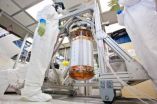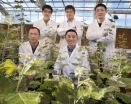(Press-News.org) Research at The University of Texas MD Anderson Cancer Center is finally unearthing some of the ancient mysteries behind leprosy, also known as Hansen's disease, which has plagued mankind throughout history. The new research findings appear in the current edition of journal PLOS Neglected Tropical Diseases. According to this new hypothesis, the disease might be the oldest human-specific infection, with roots that likely stem back millions of years.
There are hundreds of thousands of new cases of leprosy worldwide each year, but the disease is rare in the United States, with 100-200 new cases annually. Leprosy is known for attacking a patient's skin and nerves. Effective antimicrobial treatments exist today. However, when misdiagnosed or untreated, the disease can lead to extensive skin lesions, deformities in the patient's face and extremities, disabilities, and even death. Leprosy carries a social stigma and diagnosis is frequently and notoriously delayed.
An incidental yet important discovery
Work led by MD Anderson pathologist Xiang-Yang Han, M.D., Ph.D., a professor in laboratory medicine, resulted in the discovery in 2008 of a new leprosy-causing species, called Mycobacterium lepromatosis. Before that time, only one species of bacteria, called Mycobacterium leprae, was known to cause leprosy.
In the past several years, Han and other researchers have found the new leprosy agent in patients from Mexico, Canada, Brazil, Singapore, and Myanmar. Han's team, in collaboration with Francisco Silva, an evolutionary geneticist from Spain, analyzed 20 genes of Mycobacterium lepromatosis and compared them with those of Mycobacterium leprae.
They found the two leprosy bacteria came from a last common ancestor around 10 million years ago. Before the divergence, the common bacteria ancestor had undergone a massive reductive evolution that resulted in inactivation of approximately 40 percent of all the genes in its genome. Those genes went on to become non-functioning pseudogenes or were even lost. This reductive evolution, unique among all pathogenic bacteria known so far, was unearthed from genome sequencing of Mycobacterium leprae several years ago before the discovery of Mycobacterium lepromatosis, by another research team.
A unifying theory
In the newly published study, Han and Silva came to the hypothesis that leprosy has existed for millions of years. This theory was built by connecting the dots from several known facts and published studies.
One piece of evidence is the fact that leprosy is a strict human disease without other hosts or reservoirs. Once outside of the human body, leprosy bacteria are unable to grow in artificial media. One caveat is that Mycobacterium leprae is found in wild armadillos, but only in North America and South America. It's believed the animals likely first acquired the infection from early American explorers a few hundred years ago.
A second piece of evidence suggesting a long history of leprosy lies within the bacterial genome. All worldwide Mycobacterium leprae strains analyzed so far, more than 400 in total, have been found to have essentially identical genomes, or be clonal. This suggests human beings carried the leprosy bacteria when departing Africa around 100,000 years ago to populate the rest of the world. It also means that leprosy bacteria are extraordinarily stable within their human hosts, a sign of mature parasitic life far older than 100,000 years.
A third piece of evidence relates to the last common ancestor of the two known leprosy bacteria, which completed reductive evolution around 10 million years ago, resulting in a lean genome and the loss of free-living ability. A well-adapted lean parasite is confined to its specific host species and is unlikely to switch to other host species.
Lastly, the oldest age of the leprosy bacteria's pseudogenes suggest that gene inactivation began approximately 20 million years ago. This is likely the point when the ancestor of leprosy bacteria jumped to our early human ancestors and transitioned from free-living to strictly parasitic. In essence, the theory unifies the reductive evolution of the leprosy bacteria and their strict parasitic lifestyle in humans into a single continuous, long process.
Insights into the pathogenesis of leprosy
Han and Silva also brought human evolution, host genetic diversity, and host immunity into the complex picture of leprosy. Their hypothesis that leprosy existed for millions of years offers new insights into disease pathogenesis.
For example, the parasitic adaptation of the leprosy bacteria inside hominid-human hosts is similar to a very long hide-and-seek game. In this scenario, the parasite hides by mutating or removing harmful molecules while retaining protective ones. In the end, this leads to evasion from host immunity, a phenomenon commonly seen in leprosy. Finally, Han and Silva concluded that leprosy can be viewed as a natural consequence of a long parasitism.
Han, a clinical microbiologist, routinely diagnoses secondary infections caused by various kinds of microbes in patients with cancer. "Many patients who come to MD Anderson suspected of having cancer turn out to have infections instead and we make such game-changing diagnoses nearly every day" said Dr. Han.
"Discovering the new leprosy agent Mycobacterium lepromatosis was incidental. However, locating this additional leprosy cause significantly adds to our understanding of the ancient disease. In particular, tracing the ultimate origin of leprosy through the parasitic adaptive evolution of the leprosy bacteria is rather insightful, not only for this single disease but also for our better understanding of the mechanism behind other human infections. Medical historians and anthropologists may appreciate this also."
Han's team is currently focused on the decoded genome of Mycobacterium lepromatosis and its assembly.
INFORMATION:
MD Anderson researcher uncovers some of the ancient mysteries of leprosy
2014-02-20
ELSE PRESS RELEASES FROM THIS DATE:
Sustainable manufacturing system to better consider the human component
2014-02-20
CORVALLIS, Ore. – Engineers at Oregon State University have developed a new approach toward "sustainable manufacturing" that begins on the factory floor and tries to encompass the totality of manufacturing issues – including economic, environmental, and social impacts.
This approach, they say, builds on previous approaches that considered various facets of sustainability in a more individual manner. Past methods often worked backward from a finished product and rarely incorporated the complexity of human social concerns.
The findings have been published in the Journal ...
New calibration confirms LUX dark matter results
2014-02-20
PROVIDENCE, R.I. [Brown University] — A new high-accuracy calibration of the LUX (Large Underground Xenon) dark matter detector demonstrates the experiment's sensitivity to ultra-low energy events. The new analysis strongly confirms the result that low-mass dark matter particles were a no-show during the detector's initial run, which concluded last summer.
The first dark matter search results from LUX detector were announced last October. The detector proved to be exquisitely sensitive, but found no evidence of the dark matter particles during its first 90-day run, ruling ...
Better broccoli, enhanced anti-cancer benefits with longer shelf life
2014-02-20
URBANA, Ill. – While researching methods to increase the already well-recognized anti-cancer properties of broccoli, researchers at the University of Illinois also found a way to prolong the vegetable's shelf life.
And, according to the recently published study, the method is a natural and inexpensive way to produce broccoli that has even more health benefits and won't spoil so quickly on your refrigerator shelf.
Jack Juvik, a U of I crop sciences researcher, explained that the combined application of two compounds, both are natural products extracted from plants, increased ...
Smaller meals more times per day may curb obesity in cats
2014-02-20
URBANA, Ill. – Just as with people, feline obesity is most often linked to excessive food intake or not enough physical activity. Attempts to cut back on calories alone often result in failed weight loss or weight regain in both people and their pets.
So how do you encourage your cat to get more exercise?
Researchers from the University of Illinois interested in finding a method to maintain healthy body weight in cats, looked at a previously suggested claim that increased meal frequency could help to increase overall physical activity.
The idea is to feed cats the ...
Color vision problems become more common with age, reports Optometry and Vision Science
2014-02-20
Philadelphia, Pa. (February 20, 2014) - Abnormal color vision increases significantly with aging—affecting one-half or more of people in the oldest age groups, reports a study in Optometry and Vision Science, official journal of the American Academy of Optometry. The journal is published by Lippincott Williams & Wilkins, a part of Wolters Kluwer Health.
While few people younger than 70 have problems with color vision, the rate increases rapidly through later decades of life, according to the new research by Marilyn E. Schneck, PhD, and colleagues of The Smith-Kettlewell ...
Roots to shoots: Hormone transport in plants deciphered
2014-02-20
Plant growth is orchestrated by a spectrum of signals from hormones within a plant. A major group of plant hormones called cytokinins originate in the roots of plants, and their journey to growth areas on the stem and in leaves stimulates plant development. Though these phytohormones have been identified in the past, the molecular mechanism responsible for their transportation within plants was previously poorly understood.
Now, a new study from a research team led by biochemist Chang-Jun Liu at the U.S. Department of Energy's (DOE) Brookhaven National Laboratory identifies ...
New research shows the way a room is lit can affect the way you make decisions
2014-02-20
The next time you want to turn down the emotional intensity before making an important decision, you may want to dim the lights first.
A new study from the University of Toronto Scarborough shows that human emotion, whether positive or negative, is felt more intensely under bright light. Alison Jing Xu, assistant professor of management at UTSC and the Rotman School of Management, along with Aparna Labroo of Northwestern University, conducted a series of studies to examine the unusual paradox of lighting and human emotion.
"Other evidence shows that on sunny days people ...
Recurrent mouth and throat cancers less deadly when caused by virus, study shows
2014-02-20
People with late-stage cancer at the back of the mouth or throat that recurs after chemotherapy and radiation treatment are twice as likely to be alive two years later if their cancer is caused by the human papillomavirus (HPV), new research led by a Johns Hopkins scientist suggests.
Previous studies have found that people with so-called HPV-positive oropharyngeal cancers are more likely to survive than those whose cancers are related to smoking or whose origins are unknown.
The new study, scheduled to be presented Feb. 20 at the 2014 Multidisciplinary Head and Neck ...
Humidification of the mouth, throat during RT for head and neck cancer reduces mucositis, hospital stay
2014-02-20
Scottsdale, Ariz., February 20, 2014—Patients who received daily humidification of the mouth and throat region beginning from day one of radiation therapy treatment spent nearly 50 percent fewer days in the hospital to manage their side effects, according to research presented today at the 2014 Multidisciplinary Head and Neck Cancer Symposium.
The study was conducted by the Trans Tasman Radiation Oncology Group and evaluated 210 head and neck cancer patients in New Zealand and Australia from June 2007 through June 2011. Patients in this Phase III trial were randomized ...
HPV-positive OPSCC patients nearly twice as likely to survive as HPV-negative patients
2014-02-20
Scottsdale, Ariz., February 20, 2014—A retrospective analysis of oropharyngeal patients with recurrence of disease after primary therapy in the Radiation Therapy Oncology Group (RTOG) studies 0129 or 0522 found that HPV-positive patients had a higher overall survival (OS) rate than HPV-negative patients (at two years post-treatment, 54.6 percent vs. 27.6 percent, respectively), according to research presented today at the 2014 Multidisciplinary Head and Neck Cancer Symposium.
The analysis included 181 patients with stage III-IV oropharyngeal squamous cell carcinoma (OPSCC) ...


